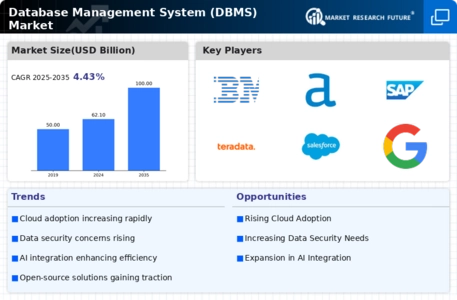Top Industry Leaders in the Database Management System Market

Competitive Landscape of Database Management System Market:
The Database Management System (DBMS) market is characterized by intense competition and dynamic trends, driven by the ever-growing demand for efficient data storage, retrieval, and management solutions. Key players in this market employ various strategies to maintain and enhance their market positions, while new and emerging companies seek to carve out their niche. Understanding the competitive landscape involves analyzing the strategies adopted by key players, factors influencing market share, and the investment trends shaping the industry.
Key Players:
- Huawei Technologies Co Ltd
- Cockroach Labs
- Oracle Corporation
- DataStax Inc.
- Microsoft Corporation
- MarkLogic Corporation
- Neo Technologies SA
- InterSystems Corporation
- IBM Corporation
Strategies Adopted:
- Cloud Integration: Key players emphasize cloud integration, providing scalable and flexible solutions that align with the growing trend of cloud adoption among enterprises.
- Data Security and Compliance: Given the rising concerns about data security, strategies focus on robust security measures and compliance adherence to gain the trust of enterprises dealing with sensitive information.
- Artificial Intelligence Integration: Incorporating AI capabilities into DBMS offerings is a strategic move to enhance data analytics and insights, catering to the increasing demand for intelligent data processing.
- Hybrid Solutions: Many companies focus on hybrid solutions, acknowledging the coexistence of on-premises and cloud-based infrastructure in enterprises. This strategy targets businesses in transition, providing flexibility in data management.
Factors for Market Share Analysis:
- Product Portfolio: The diversity and comprehensiveness of the product portfolio play a crucial role. Companies offering a wide range of DBMS solutions, catering to different business sizes and industries, are positioned well.
- Innovation: Continuous innovation in terms of features, performance, and integration capabilities allows companies to stay ahead. The ability to adapt to emerging technologies, such as blockchain and edge computing, contributes to market share.
- Customer Base: The size and loyalty of the customer base indicate market influence. Companies with a large and satisfied customer base often gain an edge as positive reviews and recommendations contribute to their market share.
- Global Presence: A strong global presence, with effective localization strategies, enables companies to tap into diverse markets. Adapting solutions to meet regional requirements enhances competitiveness.
New and Emerging Companies:
- Snowflake Inc.: Specializing in cloud data warehousing, Snowflake has gained traction for its scalable and performance-oriented solutions. Its focus on simplicity and ease of use attracts businesses looking for modern data management solutions.
- MongoDB Inc.: MongoDB's NoSQL database has found popularity among developers for its flexibility and scalability. The company's strategy revolves around supporting agile development and easing the handling of unstructured data.
- Cockroach Labs: Known for its distributed SQL database, CockroachDB, this company targets organizations with demanding scalability and resilience requirements. Its focus on distributed architecture aligns with the need for high availability in modern applications.
Current Company Investment Trends:
- Acquisitions: Companies actively pursue strategic acquisitions to broaden their product offerings, gain technological capabilities, or expand their customer base. This trend facilitates market consolidation and enhances competitiveness.
- Research and Development: Investment in R&D remains a key trend, with companies allocating resources to innovate and stay ahead in the rapidly evolving DBMS landscape. This includes developing new features, improving performance, and exploring emerging technologies.
- Partnerships and Alliances: Collaborations with other technology providers, especially in the cloud computing space, are common. Such partnerships aim to create integrated solutions, offering customers a seamless experience across different platforms.
- Focus on Customer Success: To maintain and expand market share, companies are increasingly investing in customer success programs. This involves providing comprehensive support, training, and resources to ensure clients derive maximum value from their DBMS solutions.
Latest Company Updates:
Oct 2023: Cloud Adoption: Cloud-based DBMS solutions are gaining traction due to their scalability, agility, and cost-effectiveness. AWS Aurora, Microsoft Azure SQL Database, and Google Cloud Spanner are leading players in this segment.
Nov 2023: Focus on Data Security and Privacy: With increasing data breaches and privacy concerns, organizations are prioritizing security features and compliance with regulations like GDPR and CCPA in their DBMS choices.
Sept 2023: Rise of NoSQL Databases: NoSQL databases like MongoDB and Couchbase are increasingly adopted for unstructured and semi-structured data, particularly in web applications and IoT deployments.
Dec 2023: Oracle Acquires MoData: Oracle acquired cloud data protection startup MoData in December 2023, strengthening its security offerings for cloud databases.
Nov 2023: Microsoft and SAP Partner on Data Management: Microsoft and SAP announced a strategic partnership in November 2023 to integrate their respective data management platforms, Azure Synapse Analytics and SAP HANA, for seamless data exchange and analytics.
Oct 2023: In-memory Databases: In-memory databases like SAP HANA and IBM Db2 LUW offer real-time data processing and analytics, ideal for high-speed transactions and decision-making.
Sept 2023: Graph Databases: Graph databases like Neo4j and Amazon Neptune are gaining popularity for modeling relationships between data points, particularly in social networks and fraud detection applications.
Aug 2023: AI-powered DBMS: Integration of AI and machine learning in DBMS is on the rise, enabling automated data optimization, performance tuning, and anomaly detection.

